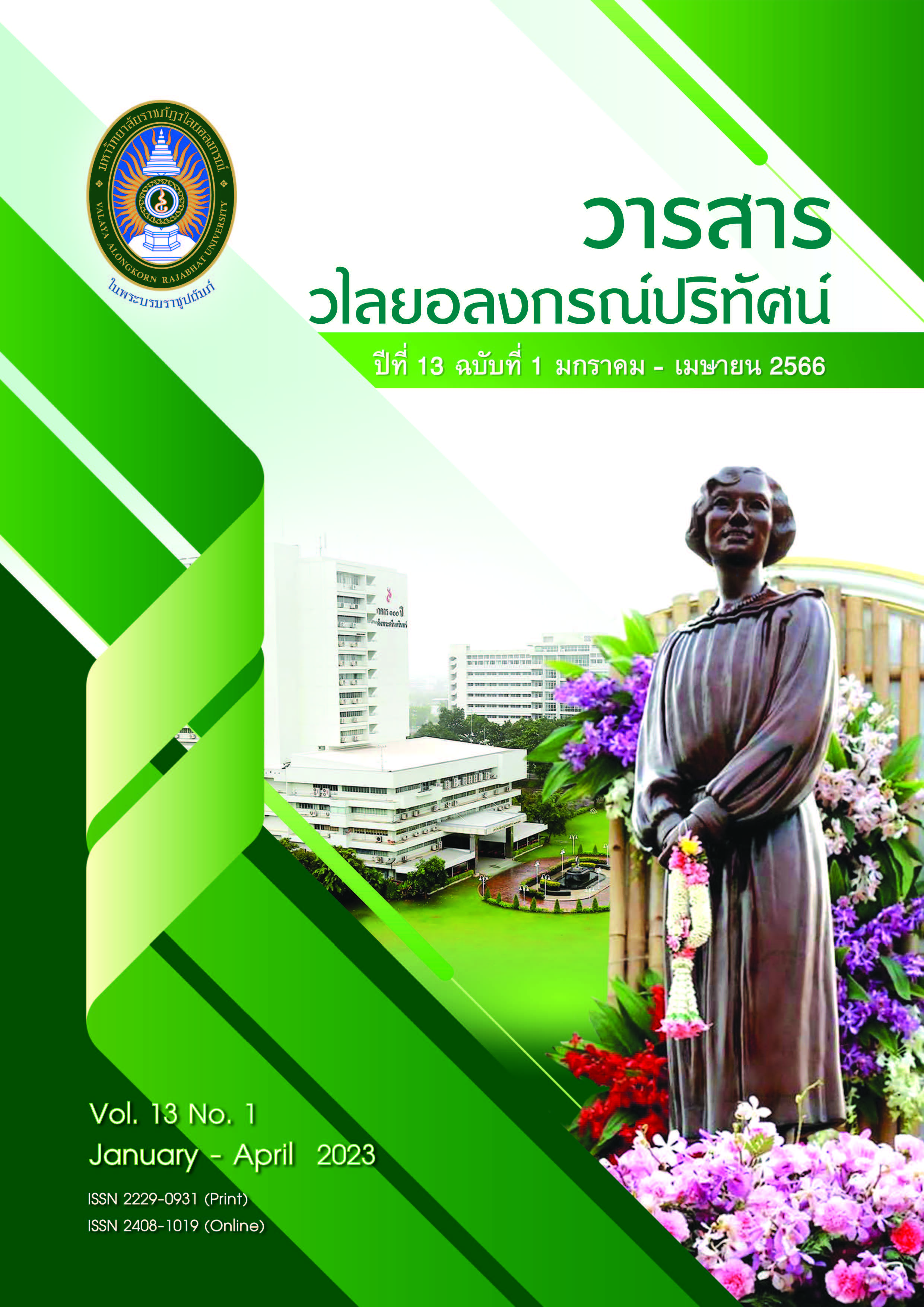การพัฒนารูปแบบการเรียนการสอนโดยใช้เครื่องมือข้อมูลเชิงโต้ตอบในชั้นเรียนรายวิชาศิลปะการชงชาเพื่อพัฒนาผลสัมฤทธิ์ทางการเรียนและความคิดสร้างสรรค์ของนักศึกษา
คำสำคัญ:
การพัฒนารูปแบบการเรียนการสอน, เครื่องมือข้อมูลเชิงโต้ตอบในชั้นเรียน, ผลสัมฤทธิ์ทางการเรียน, ความคิดสร้างสรรค์บทคัดย่อ
การวิจัยครั้งนี้มีวัตถุประสงค์เพื่อ 1) พัฒนารูปแบบการเรียนการสอนโดยใช้เครื่องมือข้อมูลเชิงโต้ตอบในชั้นเรียนรายวิชาศิลปะการชงชา 2) ประเมินผลการใช้รูปแบบการเรียนการสอน โดยใช้เครื่องมือข้อมูลเชิงโต้ตอบในชั้นเรียนรายวิชาศิลปะการชงชา โดยแบ่งออกเป็น 2.1) เปรียบเทียบผลสัมฤทธิ์ทางการเรียนก่อนและหลังการใช้รูปแบบการเรียนการสอนโดยใช้เครื่องมือข้อมูลเชิงโต้ตอบในชั้นเรียนรายวิชาศิลปะการชงชา และ 2.2) ศึกษาผลความก้าวหน้าของความคิดสร้างสรรค์ของนักศึกษาหลังการใช้รูปแบบการเรียนการสอนโดยใช้เครื่องมือข้อมูลเชิงโต้ตอบในชั้นเรียนรายวิชาศิลปะการชงชา กลุ่มตัวอย่างในการวิจัย เป็นนักศึกษาจำนวน 30 คน สาขาวิชาการจัดการโรงแรม Wuhan Business University ประเทศจีน ได้มาโดยการสุ่มแบบกลุ่ม เครื่องมือที่ใช้ในการวิจัย ได้แก่ 1) แบบประเมินรูปแบบการเรียนการสอนโดยใช้เครื่องมือข้อมูลเชิงโต้ตอบในชั้นเรียนรายวิชาศิลปะการชงชา 2) แผนการจัดการเรียนรู้ มีค่าความสอดคล้องอยู่ระหว่าง 0.67 - 1.00 3) แบบทดสอบ วัดผลสัมฤทธิ์ทางการเรียน ประกอบด้วยแบบวัดความรู้และแบบวัดทักษะ โดยแบบวัดความรู้ มีค่าความสอดคล้องอยู่ระหว่าง 0.80 - 1.00 ค่าความยากง่าย อยู่ระหว่าง 0.53 - 0.80 ค่าอำนาจจำแนกอยู่ระหว่าง 0.25 - 0.63 และค่าความเชื่อมั่นโดยใช้สูตร KR-20 เท่ากับ 0.83 และแบบวัดทักษะ มีค่าความสอดคล้องอยู่ระหว่าง 0.60 - 1.00 และค่าความเชื่อมั่น เท่ากับ 0.92 และ 4) แบบทดสอบความคิดสร้างสรรค์ มีค่าดัชนีความสอดคล้องอยู่ระหว่าง 0.60 - 1.00 และค่าความเชื่อมั่น เท่ากับ 0.92 วิเคราะห์ข้อมูลโดยการหาค่าเฉลี่ย ส่วนเบี่ยงเบนมาตรฐาน การทดสอบค่าที และการทดสอบ ความแปรปรวนแบบวัดซ้ำ
ผลการวิจัยพบว่า
1. รูปแบบการเรียนการสอนโดยใช้เครื่องมือข้อมูลเชิงโต้ตอบในชั้นเรียนรายวิชาศิลปะ การชงชา ประกอบด้วย 6 องค์ประกอบหลัก ได้แก่ 1) หลักการ 2) วัตถุประสงค์ 3) กระบวนการสอน 4) บทบาทของครูและผู้เรียน 5) สื่อการเรียนการสอน/ระบบสนับสนุน และ 6) การประเมินการเรียนรู้ ผลการประเมินโดยผู้เชี่ยวชาญ พบว่า รูปแบบการเรียนการสอนมีความเหมาะสมโดยรวม อยู่ในระดับมาก (M = 4.38, S.D. = 0.52)
2. นักศึกษามีความคิดสร้างสรรค์สูงขึ้นในแต่ละระยะ (F = 327.171, p = 0.000)
3. นักศึกษามีผลสัมฤทธิ์ทางการเรียนวิชาศิลปะการชงชาหลังเรียนสูงกว่าก่อนเรียน อย่างมีนัยสำคัญทางสถิติที่ระดับ .05 (t = 75.293, p = 0.000)
เอกสารอ้างอิง
Bai, B. (2019). Analysis of the current situation and development of tea art teaching in Guangdong. Master’s thesis. South China Agricultural University.
Campbell, D. T., & Stanley, J. (1963). Experimental and quasi-experimental designs for research. Chicago, IL: Rand McNally.
Cao, X. & Yang, F. (2006). Problems and countermeasures in the design of information-based teaching. China Electronic Education. (09), 56-57.
China Education News. (2017). Develop education informatization and promote education modernization 2030. [Online], Available: http://www.moe.gov.cn/jyb_xwfb/moe_176/201703/t20170327_300988.html
Han, C., Zhao, M., Zhang, X., & Wang, J. (2017). Research and investigation on the current situation of college students in Yantai City, "the bow-headed people". China Health Statistics. 12 (34), 6.
He, R. (2013). A Brief Discussion on the Quality of Classroom Teaching for College Students. Education and Teaching Forum. (40): 119-121.
Hou, Y. (2009). Research on effective classroom interaction. Master’s thesis. East China Normal University.
Jitsopitanon, J., Chaijaroen, S., & Vongtathum, P. (2021). The Validation of Constructivist Web-Based Learning Environment Model to Enhance Creativity Thinking for Undergraduate Student with Integration of Pedagogy and Neuroscience. Innovative Technologies and Learning: 4th International Conference. (4): 181-183.
Joyce, B. & Weil, M., (2009). Models of teaching. (8th ed.). Boston, MA: Allyn and Bacon.
Li, J. (2016). The harm, causes and coping strategies of mobile phone dependence on college students in the new era. Fujian Quality Management. 8(01), 25-29.
Li, Y. (2021). The rule of changes in creative thinking of college students and its neural basis. Doctoral dissertation. Tianjin Normal University.
Teng, M. (2009). Teacher Factors of College Students' Classroom Silence. Heilongjiang Higher Education Research. (04), 146-148.
Wang, J. (2017). Analysis and Research on Mobile Phone Dependence and Classroom Quality Control of College Students. Journal of Wuxi Commercial Vocational and Technical College. 17(03), 67-71.
Wang, Y., Guo, H., & Bian, X. (2013). Statistical Analysis and Modeling of College Students' Learning Status. Journal of Liaoning University of Engineering and Technology (Natural Science Edition). (11), 1564-1567.
Wang, Z. (2018). Analysis on the problem of college students' mobile phone pockets in classrooms. Journal of Jiangxi Electric Power Vocational and Technical College. 31(02), 131-133+136.
Xiao, Y. (2005). Problems and root causes of college classroom teaching in the cultivation of college students' innovative ability. Heilongjiang Higher Education Research. 1(08), 121-123.
Xu, G., et al. (2014). Research on the relationship between mobile phone dependence and classroom learning efficiency of college students. Journal of Zhejiang Sci-Tech University. 32(12), 535-538, 543.
Zhang, S. (2021). Application Research of Blended teaching model based on rain classroom - A case study of junior middle school Information technology curriculum. Master's thesis: Shihezi University.
ดาวน์โหลด
เผยแพร่แล้ว
รูปแบบการอ้างอิง
ฉบับ
ประเภทบทความ
สัญญาอนุญาต
ลิขสิทธิ์ (c) 2023 หลิว หญิงหญิง, เลอลักษณ์ โอทกานนท์, เรขา อรัญวงศ์, ดนุชา สลีวงศ์

อนุญาตภายใต้เงื่อนไข Creative Commons Attribution-NonCommercial-NoDerivatives 4.0 International License.
ข้อความที่ปรากฏในบทความแต่ละเรื่องในวารสารวไลยอลงกรณ์ปริทัศน์ เป็นความคิดเห็นของผู้นิพนธ์แต่ละท่าน มิใช่เป็นทัศนะและมิใช่ความรับผิดชอบของกองบรรณาธิการจัดทำวารสาร และ
มหาวิทยาลัยราชภัฏวไลยอลงกรณ์ ในพระบรมราชูปถัมภ์


